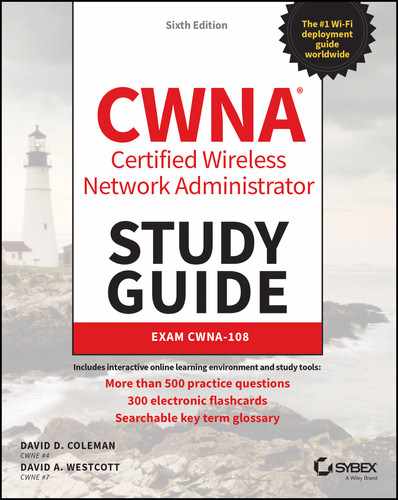The #1 selling Wi-Fi networking reference guide in the world The CWNA: Certified Wireless Network Administrator Study Guide is the ultimate preparation resource for the CWNA exam. Fully updated to align with the latest version of the exam, this book features expert coverage of all exam objectives to help you pass the exam. But passing the exam is just a first step. For over 16 years, the CWNA Study Guide has helped individuals jump-start their wireless networking careers. Wireless networking professionals across the globe use this book as their workplace reference guide for enterprise Wi-Fi technology. Owning this book provides you with a foundation of knowledge for important Wi-Fi networking topics, including: The book authors have over 40 years of combined Wi-Fi networking expertise and provide real-world insights that you can leverage in your wireless networking career. Each of the book’s 20 chapters breaks down complex topics into easy to understand nuggets of useful information. Each chapter has review questions that help you gauge your progress along the way. Additionally, hands-on exercises allow you to practice applying CWNA concepts to real-world scenarios. You also get a year of free access to the Sybex online interactive learning environment, which features additional resources and study aids, including bonus practice exam questions. The CWNA certification is a de facto standard for anyone working with wireless technology. It shows employers that you have demonstrated competence in critical areas, and have the knowledge and skills to perform essential duties that keep their wireless networks functioning and safe. The CWNA: Certified Wireless Network Administrator Study Guide gives you everything you need to pass the exam with flying colors.
Table of Contents
- Cover
- Title Page
- Copyright
- Dedication
- Acknowledgments
- About the Authors
- About the Technical Editor
- Table of Exercises
- Foreword
- Introduction
- Chapter 1: Overview of Wireless Standards, Organizations, and Fundamentals
- Chapter 2: IEEE 802.11 Standard and Amendments
- Chapter 3: Radio Frequency Fundamentals
- Chapter 4: Radio Frequency Components, Measurements, and Mathematics
- Chapter 5: Radio Frequency Signal and Antenna Concepts
- Azimuth and Elevation Charts (Antenna Radiation Envelopes)
- Interpreting Polar Charts
- Beamwidth
- Antenna Types
- Visual Line of Sight
- RF Line of Sight
- Fresnel Zone
- Earth Bulge
- Antenna Polarization
- Antenna Diversity
- Multiple-Input, Multiple-Output
- Antenna Connection and Installation
- Antenna Accessories
- Regulatory Compliance
- Summary
- Exam Essentials
- Review Questions
- Chapter 6: Wireless Networks and Spread Spectrum Technologies
- Throughput vs. Bandwidth
- Narrowband and Spread Spectrum
- Frequency-Hopping Spread Spectrum
- Direct-Sequence Spread Spectrum
- Orthogonal Frequency-Division Multiplexing
- Industrial, Scientific, and Medical Bands
- 5 GHz Unlicensed National Information Infrastructure Bands
- 60 GHz for Wi-Fi
- Below 1 GHz
- 2.4 GHz Channels
- 5 GHz Channels
- 6 GHz Channels
- Summary
- Exam Essentials
- Review Questions
- Chapter 7: Wireless LAN Topologies
- Chapter 8: 802.11 Medium Access
- Chapter 9: 802.11 MAC
- Chapter 10: MIMO Technology: HT and VHT
- Chapter 11: WLAN Architecture
- Chapter 12: Power over Ethernet (PoE)
- Chapter 13: WLAN Design Concepts
- Chapter 14: Site Survey and Validation
- Chapter 15: WLAN Troubleshooting
- Chapter 16: Wireless Attacks, Intrusion Monitoring, and Policy
- Chapter 17: 802.11 Network Security Architecture
- Chapter 18: Bring Your Own Device (BYOD) and Guest Access
- Chapter 19: 802.11ax: High Efficiency (HE)
- Chapter 20: WLAN Deployment and Vertical Markets
- Deployment Considerations for Commonly Supported WLAN Applications and Devices
- Corporate Data Access and End-User Mobility
- Network Extension to Remote Areas
- Bridging: Building-to-Building Connectivity
- Wireless ISP: Last-Mile Data Delivery
- Small Office/Home Office
- Temporary Office Networking
- Branch Offices
- Teleworker Wi-Fi
- Educational/Classroom Use
- Industrial: Warehousing and Manufacturing
- Retail
- Healthcare
- Municipal Networks
- Hotspots: Public Network Access
- Stadium Networks
- Transportation Networks
- Law Enforcement Networks
- First-Responder Networks
- Managed Service Providers
- Fixed Mobile Convergence
- WLAN and Health
- Internet of Things
- WLAN Vendors
- Summary
- Exam Essentials
- Review Questions
- Appendix A: Answers to Review Questions
- Chapter 1: Overview of Wireless Standards, Organizations, and Fundamentals
- Chapter 2: IEEE 802.11 Standard and Amendments
- Chapter 3: Radio Frequency Fundamentals
- Chapter 4: Radio Frequency Components, Measurements, and Mathematics
- Chapter 5: Radio Frequency Signal and Antenna Concepts
- Chapter 6: Wireless Networks and Spread Spectrum Technologies
- Chapter 7: Wireless LAN Topologies
- Chapter 8: 802.11 Medium Access
- Chapter 9: 802.11 MAC
- Chapter 10: MIMO Technology: HT and VHT
- Chapter 11: WLAN Architecture
- Chapter 12: Power over Ethernet (PoE)
- Chapter 13: WLAN Design Concepts
- Chapter 14: Site Survey and Validation
- Chapter 15: WLAN Troubleshooting
- Chapter 16: Wireless Attacks, Intrusion Monitoring, and Policy
- Chapter 17: 802.11 Network Security Architecture
- Chapter 18: Bring Your Own Device (BYOD) and Guest Access
- Chapter 19: 802.11ax: High Efficiency (HE)
- Chapter 20: WLAN Deployment and Vertical Markets
- Appendix B: Abbreviations and Acronyms
- Index
- Comprehensive Online Learning Environment
- End User License Agreement
